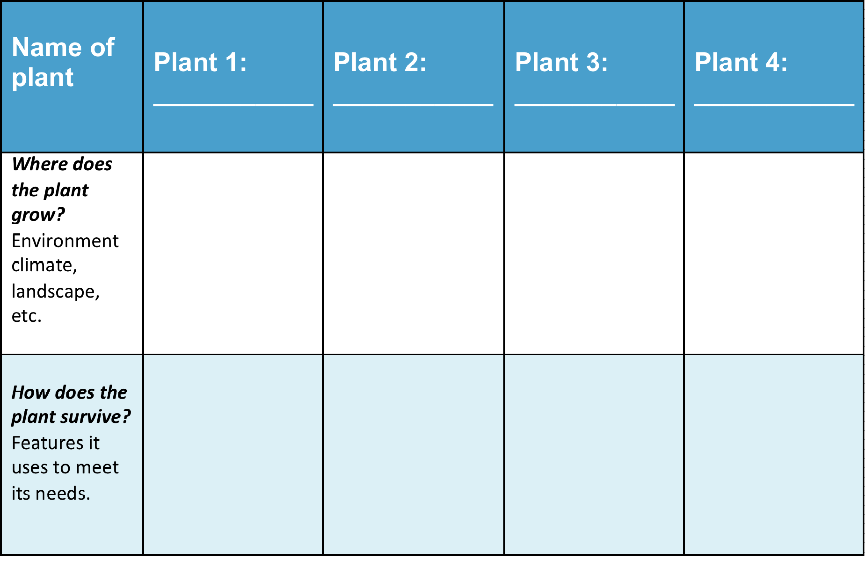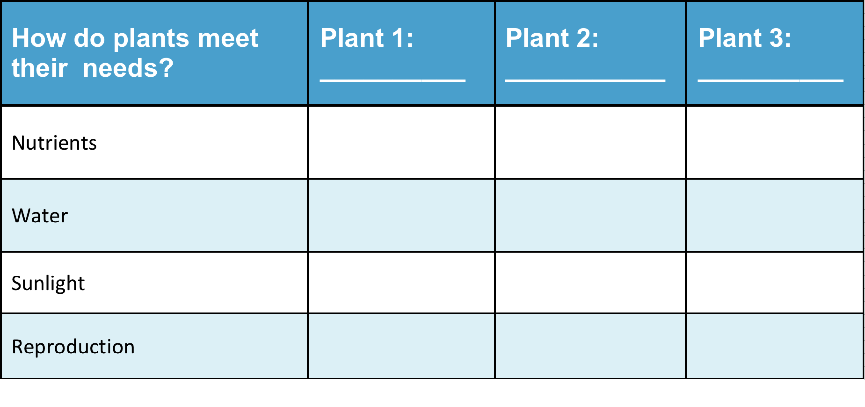Information for Teachers
Curriculum links
Australian Science Standards
BS (ACSSU43) Structural features and adaptations of living things assist their survival
BS (ACSSU43) Adaptations of living things for particular environments
ESS (ACSSU078) The role of the sun as a provider of energy for the Earth
New Zealand Science Achievement Objectives
LW: The key structural features and functions to the life processes of plants and animals
LW: The importance of variation within a changing environment
Helpful websites
You may want to direct your students to some or all of these websites to help with their investigations.
http://www.biology4kids.com/files/plants_main.html
https://www.dkfindout.com/us/animals-and-nature/plants/
https://www.desertmuseum.org/programs/succulents_adaptation.php
https://animals.sandiegozoo.org/plants/carniverous-plants
Students can use words like these in doing their search: carnivorous plants, photosynthesis, pollination, plant reproduction, etc.
They may want to learn more about plants that live in a particular environment, e.g. rainforest plants or desert plants. Or do a search about plant survival in these places by using the name of the habitat, e.g. plant+survival+rainforests, plant+survival+deserts, plant+survival+tundra
How to search the internet
1 Keep your request short
Fewer words will give a more accurate search.
2 Choose exactly what you want
For example: Arctic Circle Climate
3 Use quotes
Double quotes around a set of words tell the search engine to consider those exact words in that exact order without any change. For example: “Arctic Circle Climate”
4 Use the plus sign (+)
If you add a plus sign (+) between words, the internet will search for all the words. For example: migrate+birds+whales+mammal
5 Use the minus sign (–) to say what you don’t want
Use a minus sign (–) to show words you do not want to appear in your results. For example: if you search for burrowing animals and do not want mammals in your search, –mammals will exclude mammals. Note that you need to put a space before the minus sign for the word to be excluded.
6 Be very clear about what you don’t want
Part 1
Ask questions and make predictions
After reading How Do Plants Survive? you may have many questions about the amazing world of plants.
List your questions.
- Compare your list with questions that others have.
- Choose a question you would like to investigate.
- You can work alone, with a partner, or in a small group.
You may want to choose one or more of these questions to investigate
Q1. What other plants get their nutrients by ingesting animals?
Q2. What other plants can survive in extreme climates such as deserts?
Q3. What plants grow in water? How do these plants survive?
Q4. What features help plants to survive in various types of environments?
Go to Part 2 Plan and investigate →Part 2
Plan and investigate
Do searches in the internet or in books or talk to people who can help to find the information you are looking for.
Your teacher may suggest suitable websites for further information.
Go to Part 3 Record and analyse data →Part 3
Record and analyse data
Find ways of recording your information that will allow you to see any patterns in the data.
Data Chart for plant survival and adaptations
(Download and change to suit your information)
 Download Chart
Download Chart
Go to Part 4 Evaluate the information →
Part 4
Evaluate the information
1. Look over the information you have gathered and the patterns you have found.
What do most plants have in common?
What differences have you discovered between the plants you have investigated?
How do the plants you investigated meet their needs: nutrients, water, sunlight, etc.
2. Search for other patterns.
What adaptations have the plants you investigated developed to survive in the environments where they live?
How do the features of plants reflect the environments they grow in?
3. Makes notes about what you find.
Go to Part 5 Communicate and share ideas →Part 5
Communicate and share ideas
Look over all of the information that you have gathered in your investigation.
What are the most important ideas about how plants survive?
Make a chart showing the most important ideas.
 Download Chart
Download Chart
← Return to menu
